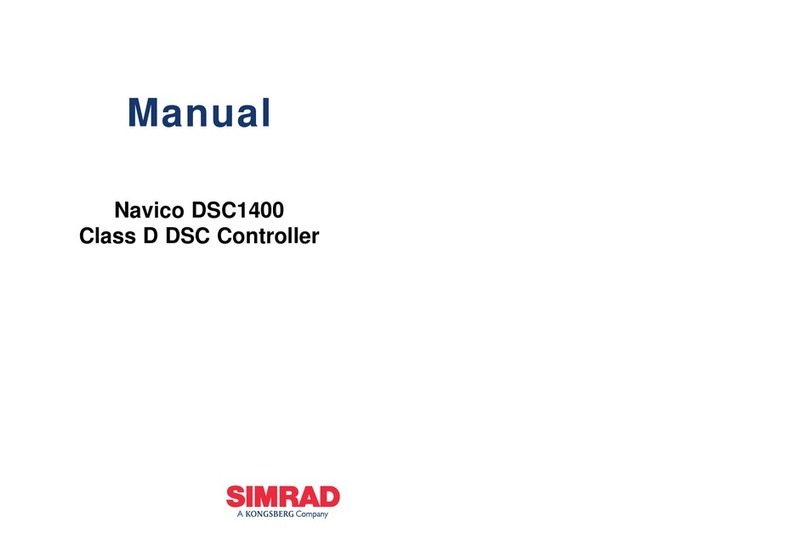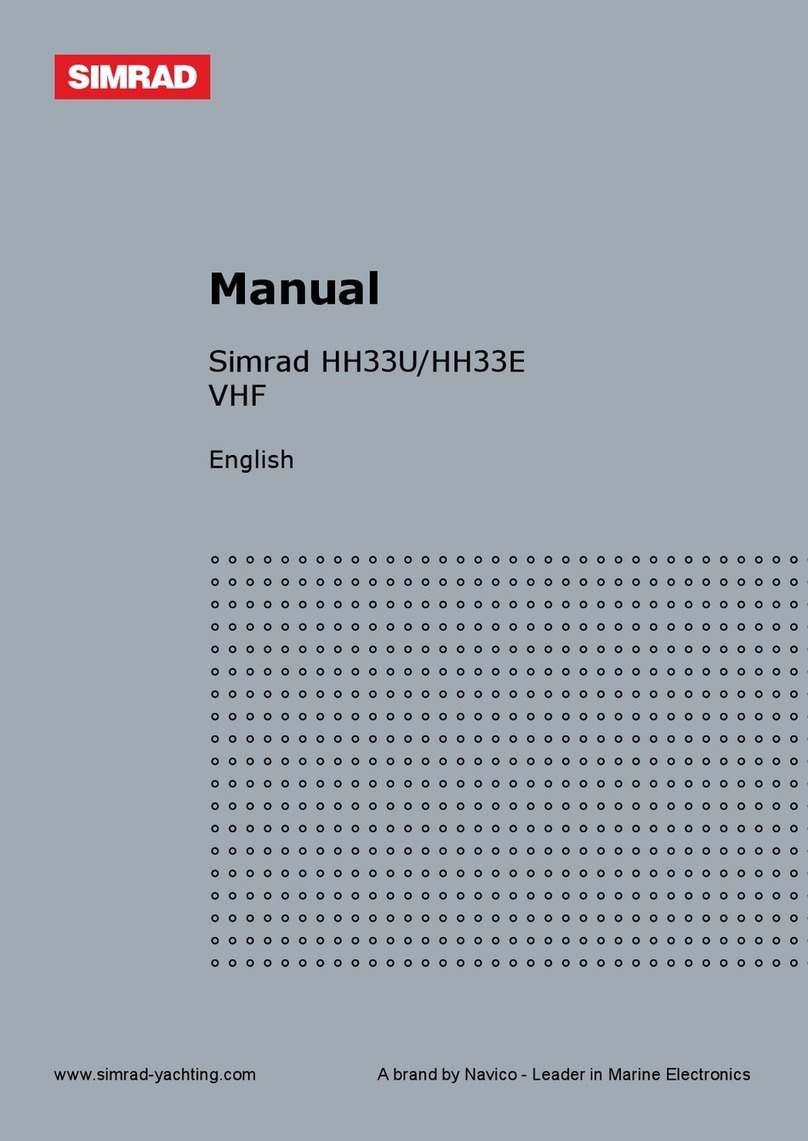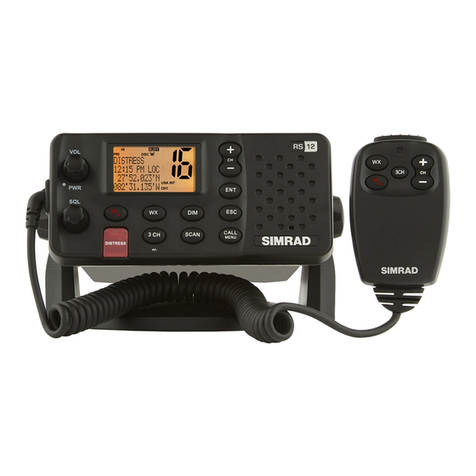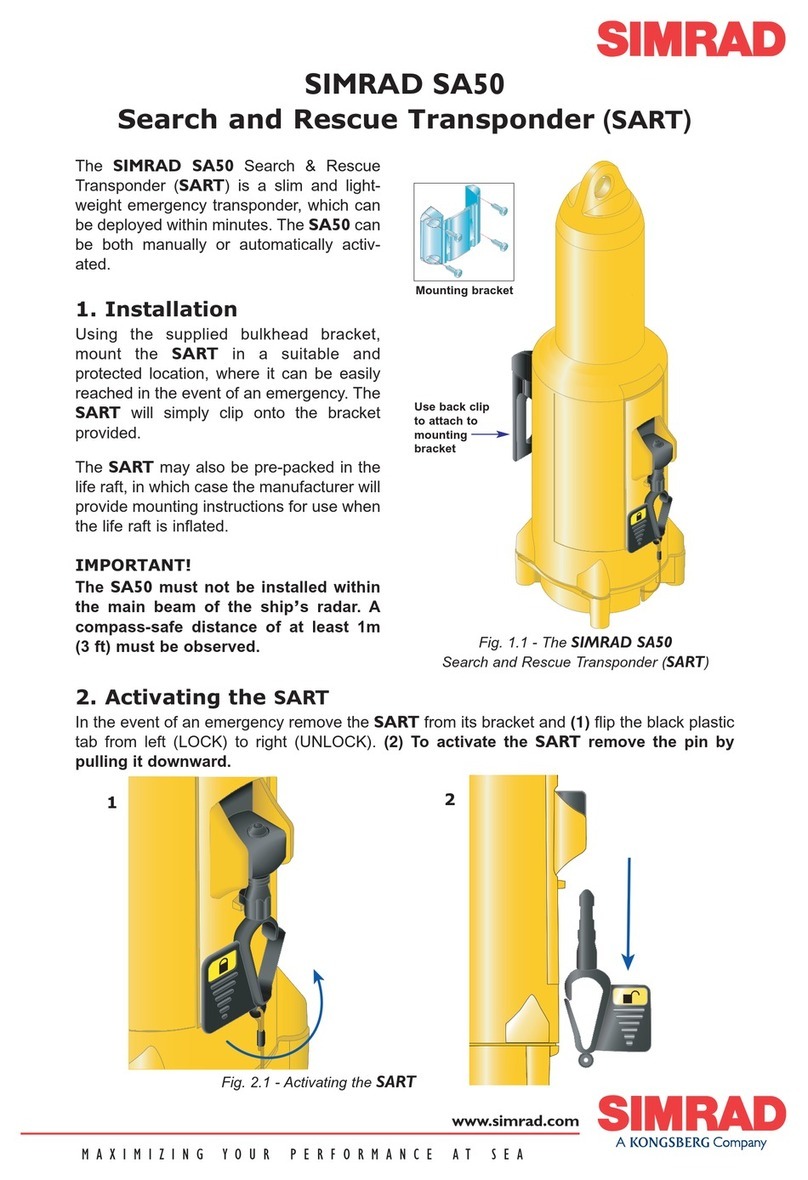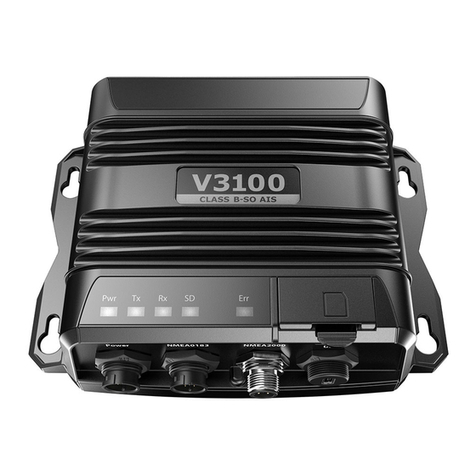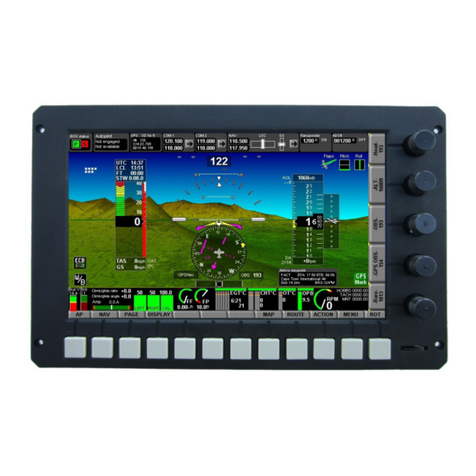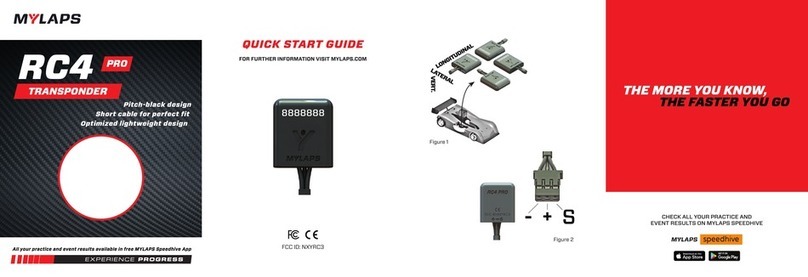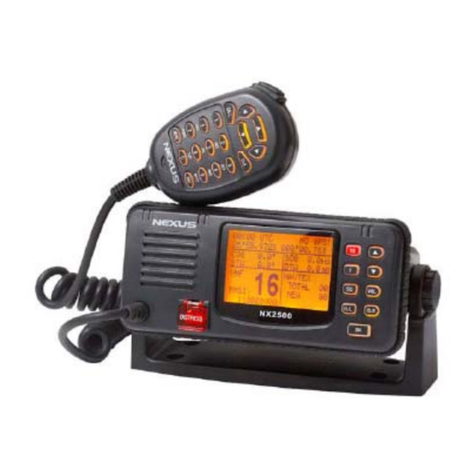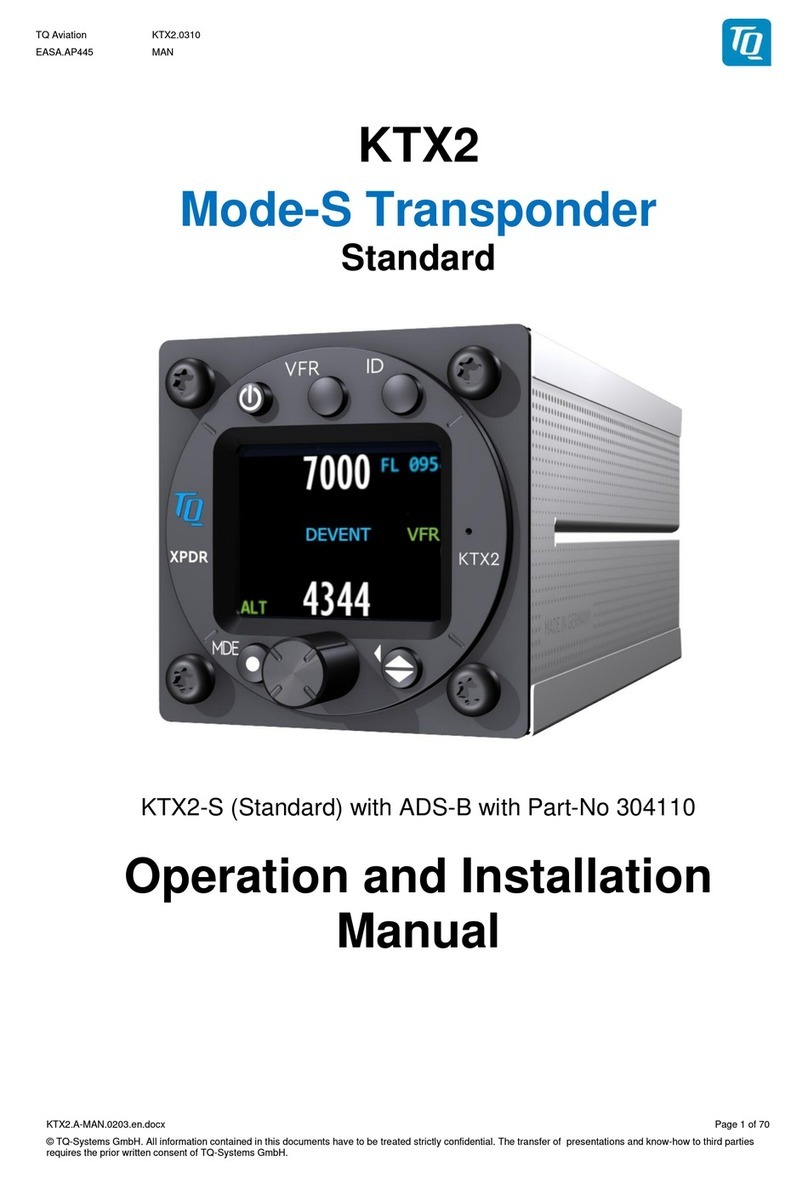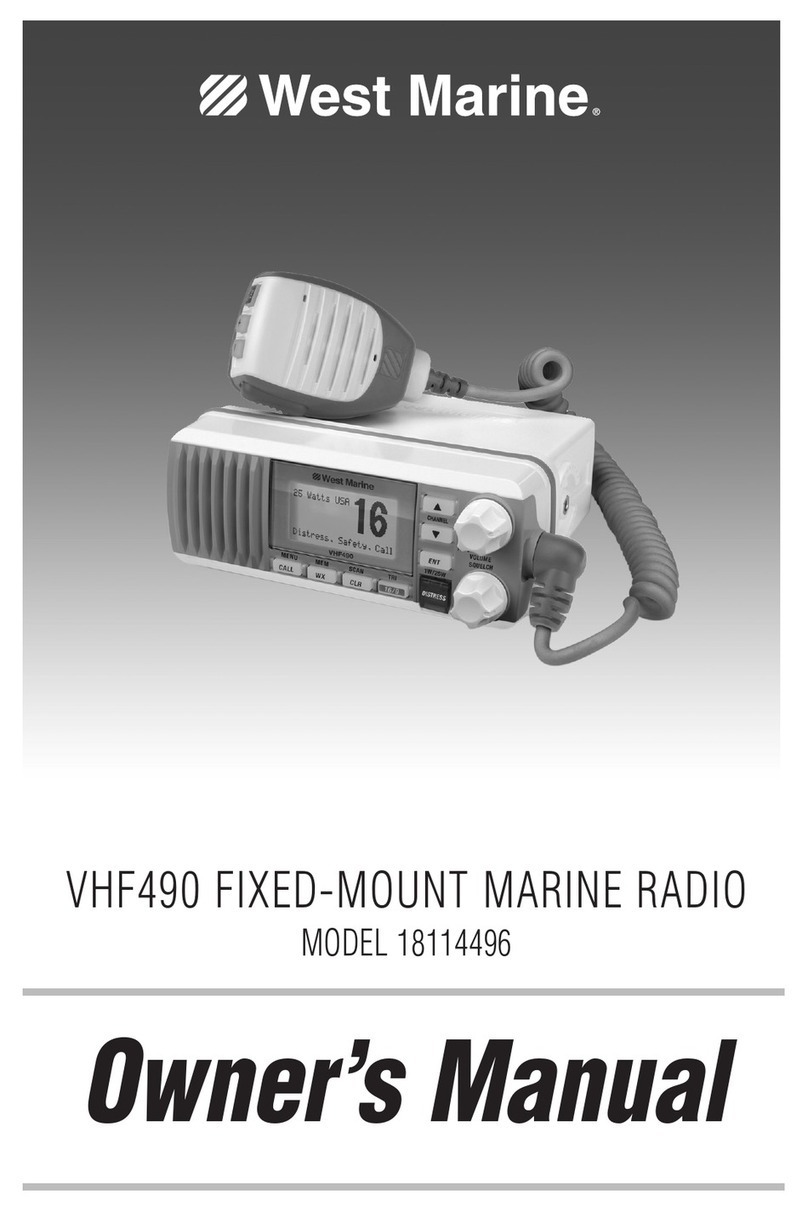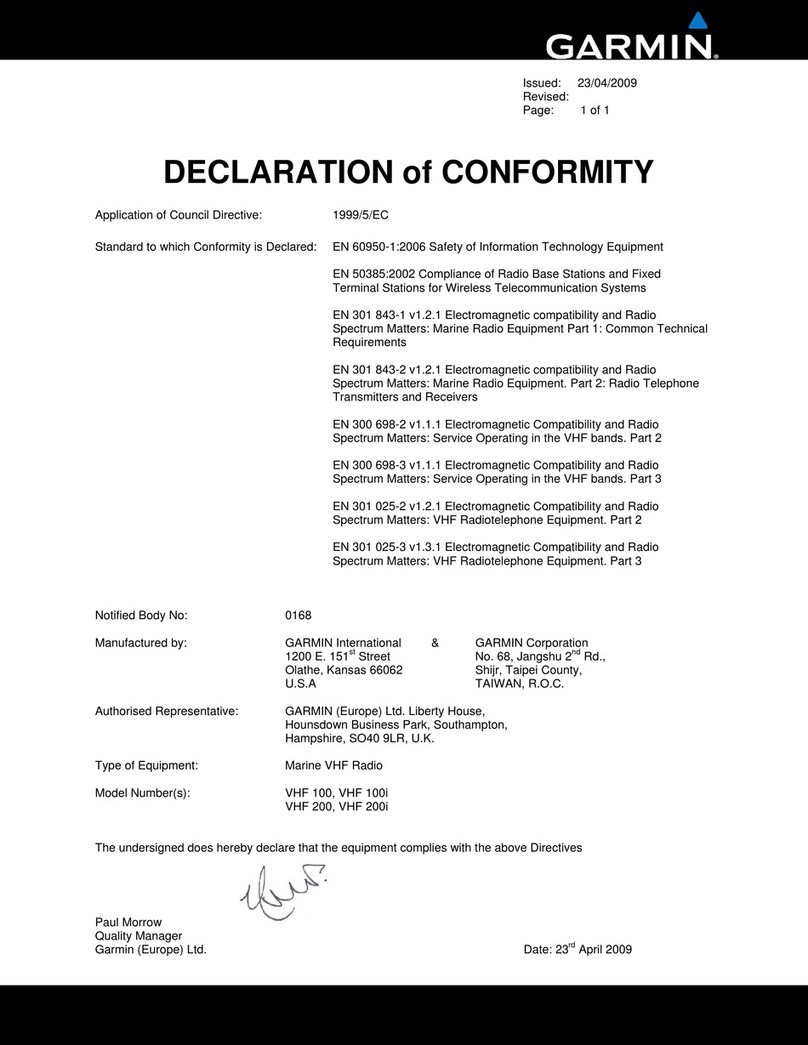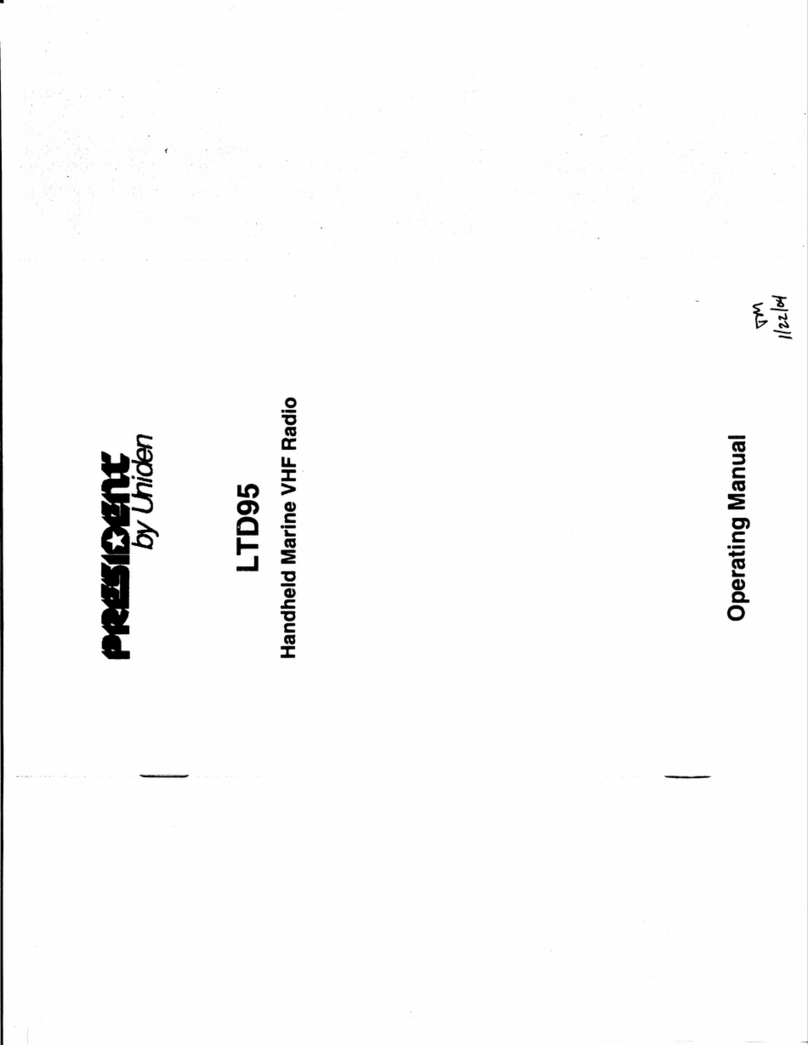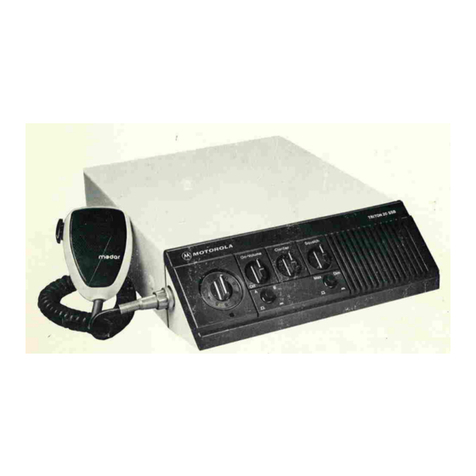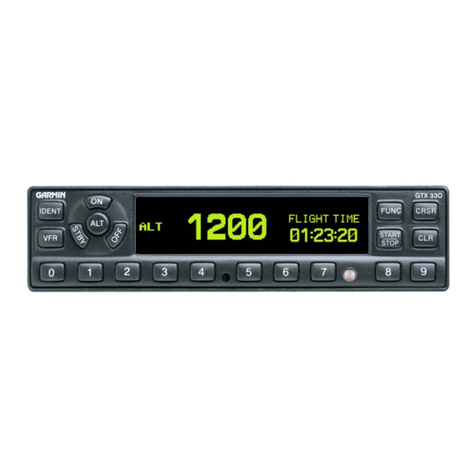Simrad RS90 User manual

ENGLISH
RS90
Operating Manual
simrad-yachting.com


| 3
RS90 Operating Manual
Preface
Copyright © 2014 Navico. All rights reserved.
Simrad® is a registered trademark of Navico
No part of this manual may be copied, reproduced, republished,
transmitted or distributed for any purpose, without prior written
consent of Simrad Electronics. Any unauthorized commercial
distribution of this manual is strictly prohibited.
Simrad Electronics may find it necessary to change or end our policies,
regulations, and special offers at any time. We reserve the right to do
so without notice. All features and specifications subject to change
without notice.
All screens in this manual are simulated.
For free owner’s manuals and the most current information on this
product, its operation and accessories, visit our web site:
www.simrad-yachting.com
Navico Holding AS is not responsible for any changes or modifications
to the radio not expressly approved by Navico AS as the responsible
entity for its compliance. Modifications could void the user’s authority
to operate the radio.
Compliance statements
DISCLAIMER: It is the owner’s sole responsibility to install and use
the instrument and peripheral components in a manner that will
not cause accidents, personal injury or property damage. The user
of this product is solely responsible for observing safe boating
practices.
NAVICO HOLDING AS. AND ITS SUBSIDIARIES, BRANCHES AND
AFFILIATES DISCLAIM ALL LIABILITY FOR ANY USE OF THIS PRODUCT
IN A WAY THAT MAY CAUSE ACCIDENTS, DAMAGE OR THAT MAY
VIOLATE THE LAW.
Governing Language: This statement, any instruction manuals,
user guides and other information relating to the product
(Documentation) may be translated to, or has been translated from,
another language (Translation). In the event of any conflict between
any Translation of the Documentation, the English language
version of the Documentation will be the official version of the
Documentation.

4 | RS90 Operating Manual
This manual represents the RS90 as at the time of printing. Navico
Holding AS. and its subsidiaries, branches and affiliates reserve the
right to make changes to specifications without notice.
IMPORTANT
1. DSC functions will not operate on the RS90 until your MMSI has
been entered.
2. The radio channels installed into this Simrad VHF radio may
vary from country to country depending upon the model and
government or national communications authority regulations.
3. Navico recommends that you check the radio operating licensing
requirements of your country before using this Simrad VHF radio.
The operator is solely responsible for observing proper radio
installation and usage practices.
4. A DSC warning label is supplied with this Simrad VHF radio. To
comply with FCC regulations, this label must be affixed in a location
that is clearly visible from the operating controls of this radio. Make
sure that the chosen location is clean and dry before applying this
label.
5. This radio is designed to generate a digital maritime distress call to
facilitate search and rescue. To be effective as a safety device, this
radio must be used only within the geographic range of a shore-
based VHF marine Channel 70 distress and safety watch system.
The geographic range may vary but under normal conditions is
approximately 20 nautical miles.
MMSI and license information
You must obtain a user MMSI (Maritime Mobile Service Identity)
and enter it into your RS90 radio in order to use the DSC functions.
Similarly for the Automatic Terminal Information Service (ATIS)
MMSI. Contact the appropriate authorities in your country. If you are
unsure who to contact, consult your Simrad dealer.
The user MMSI is a unique nine digit number, similar to a personal
telephone number. It is used on marine transceivers that are
capable of using DSC (Digital Select Calling).
Depending upon your location, you may need a radio station
license for the RS90 You may also need an individual operator’s
license.

| 5
RS90 Operating Manual
Simrad recommends that you check the requirements of your
national radio communications authorities before operating DSC
functions.
RF emissions notice
This equipment complies with FCC radiation exposure limits set
forth for an uncontrolled environment. This device’s antenna must
be installed in accordance with provided instructions; and it must
be operated with minimum 96 cm spacing between the antennas
and all person’s body (excluding extremities of hands, wrist and feet)
during operation. Further, this transmitter must not be co-located or
operated in conjunction with any other antenna or transmitter.
FCC statement
This device complies with Part 15 of the FCC Rules. Operation
is subject to the following two conditions: (1) this device may
not cause harmful interference, and (2) this device must accept
any interference received, including interference that may cause
undesired operation.
¼Note: This equipment has been tested and found to comply with
the limits for a Class B digital device, pursuant to Part 15 of the FCC
Rules. These limits are designed to provide reasonable protection
against harmful interference in a normal installation. This equipment
generates, uses and can radiate radio frequency energy and, if not
installed and used in accordance with the instructions, may cause
harmful interference to radio communications. However, there is no
guarantee that interference will not occur in a particular installation.
If this equipment does cause harmful interference to radio or
television reception, which can be determined by turning the
equipment off and on, the user is encouraged to try to correct the
interference by one or more of the following measures:
• Reorient or relocate the receiving antenna.
• Increase the separation between the equipment and receiver.
• Connect the equipment into an output on a circuit different from
that to which the receiver is connected.
• Consult the dealer or an experienced technician for help.
• A shielded cable must be used when connecting a peripheral to the
serial ports.

6 | RS90 Operating Manual
Industry Canada statement
This device complies with Industry Canada license-exempt RSS
standard(s).
Operation is subject to the following two conditions: (1) this device
may not cause interference, and (2) this device must accept any
interference, including interference that may cause undesired
operation of the devise.
Le présent appareil est conforme aux CNR d’industrie Canada
applicables aux appareils radio exempts de licence.
L’exploitation est autorisée aux deux conditions suivantes : (1)
l’appareil ne doit pa produire de brouillage, et (2) l’utilisateur de
l’appareil doit accepter tout brouillage radioélectrique subi, même si
le brouillage est susceptible d’en compromettre le fonctionnement.
Under Industry Canada regulations, this radio transmitter may
only operate using an antenna of a type and maximum (or lesser)
gain approved for the transmitter by Industry Canada. To reduce
potential radio interference to other users, the antenna type and its
gain should be so chosen that the equivalent isotropically radiated
power (e.i.r.p.) is not more than that necessary for successful
communication.
Conformément à la réglementation d’Industrie Canada, le présent
émetteur radio peut fonctionner avec une antenne d’un type et
d’un gain maximal (ou inférieur) approuvé pour l’émetteur par
Industrie Canada. Dans le but de réduire les risques de brouillage
radioélectrique à l’intention des autres utilisateurs, il faut choisir
le type d’antenne et son gain de sorte que la puissance isotrope
rayonnée quivalente (p.i.r.e.) ne dépassepas l’intensité nécessaire à
l’établissement d’une communication satisfaisante.
Notice specic to the HS35 handset
This ISM device complies with Canadian ICES-001.
Maintain a minimum separation of 2.5 cm (1 inch) from the face.
Cet appareil ISM est conforme à la norme NMB-001 du Canada.
Maintenir une distance minimum de 2,5 cm (1 inch) de la surface.

| 7
RS90 Operating Manual
CE compliance statement
This product complies with CE under R&TTE directive 1999/5/EC.
The relevant Declaration of Conformity is available in the following
website under the model documentation section:
http://www.simrad-yachting.com
Important safety information
Read carefully before installation and use
Warning: Indicates a potentially hazardous situation that could result
in death or serious injury.
Caution: Indicates a potentially hazardous situation that could result in
minor or moderate injury.

8 | Contents | RS90 Operating Manual
Contents
11 About this manual
12 System Overview
12 Introduction
13 RS90 Transceiver
14 System overview diagram
16 Getting started
16 Handsets
19 Handset control buttons
20 Keys
21 Switching on and off
23 The standby screen
23 Modes
24 Changing channel
26 Adjusting the volume
26 Adjusting squelch
27 Setting transmission power
27 PTT Key
28 Using the menus
28 Shortcut Keys
29 Entering data
29 Warning messages
29 Alert tones
30 Operating procedures
30 Making a routine radio call
30 Calling a buddy
31 Making a channel 16/9 distress call
31 Making a DSC distress call
32 Receiving weather alerts (US model only)
32 Receiving SAME alerts (US model only)
33 Favourite channel (non-US models)
34 Three favourite channels 3CH
34 Scanning channels
37 Using the hailer
38 Using the fog horn

| 9
Contents | RS90 Operating Manual
39 Using the intercom
39 Using the announce function
40 Using the voice recorder
40 Sharing NMEA 2000 data
41 Waypoint procedures
41 Adding a new waypoint
42 Editing a waypoint
42 Deleting a waypoint
43 Navigating to a waypoint
45 DSC Procedures
45 Introduction to DSC
47 DSC Distress calls
51 Sending routine DSC calls
63 Receiving DSC calls
69 ATIS
70 AIS procedures
71 List of nearby vessels
71 PPI display
72 T/CPA screen
73 AIS Target information
74 Setup
74 Wireless handset setup
75 Buddy list setup
77 Radio setup
84 DSC Setup
91 AIS Setup
94 GPS setup
97 General setup
99 Appendices
99 Appendix 1 - Troubleshooting
100 Appendix 2 - Keys reference
103 Appendix 3 - Shift keys
104 Appendix 4 - Screen symbols
105 Appendix 5 - Beep tones and call alerts
105 Appendix 6 - Warning Messages

10 | Contents | RS90 Operating Manual
106 Appendix 7 - Features
108 Appendix 8 - DSC information
108 Appendix 9 - AIS information
110 Appendix 10- Technical specification
114 Appendix 11 - US and ROW VHF marine channel charts
122 Appendix 12- EU VHF marine channel charts
128 Appendix 13 - MMSI and license information

| 11
About this manual | RS90 Operating Manual
About this manual
This manual describes the operation of the Simrad RS90 marine VHF
radio.
For instructions on installing the radio, please see the separate
manual: Simrad RS90 Marine VHF radio Installation Manual.
This manual is organized as follows:
• System Overview
Describes the components and main features of the VHF radio.
• Getting started
Explains how to use the equipment, including handsets and menus.
• Operating procedures
Explains common radio operations, such making a VHF call to a
shore station or another vessel.
• Waypoints
DSC
AIS
These sections explain how to use these more advanced features.
• Setup
Tasks you need to do initially when setting up, and thereafter from
time to time when you need to change a setting.
• Appendices
Reference sections, including trouble shooting guide, VHF channel
frequencies and technical data.
¼Note: Different setups of the RS90 marine VHF radio are provided for
different countries, depending on the VHF radio regulations of each
country.
1

12 | System Overview | RS90 Operating Manual
System Overview
Introduction
The Simrad RS90 VHF radio is a comprehensive solution for marine
VHF radio applications.
The radio comprises:
• RS90 VHF transceiver.
• One wired handset as standard, and optionally up to 3 more
wired handsets. (Maximum of 4 wired handsets in total.)
• Up to 2 optional wireless handsets.
• Up to 4 optional external speakers.
In addition to routine ship-to-ship or ship-to-shore VHF
communications, the RS90 has many advanced features, including:
• NMEA 2000 and NMEA 0183 network connectivity, which allows the
radio to share information with other onboard devices, such as a
GPS antenna, a chart plotter or a multi-function display.
• Digital Selective Calling (DSC) for automated distress calls, and for
calling individual vessels using their Maritime Mobile Service Identity
(MMSI). Also includes a track buddy function.
• Automatic Identification System (AIS) for monitoring nearby vessels
(receive only).
• Automatic Terminal Information Service (ATIS) function for controlled
VHF communications in European inland waterways (EU models).
• Automatic weather alert using TONE and SAME systems (US models).
• Monitoring multiple VHF channels simultaneously (country specific).
• Intercom calls between handsets.
• Voice recording.
• Fog horn and loud-hailer modes.
• Horn button connection.
• Up to three instant favourite channel selections.
For detailed features and specifications, see“Appendix 10 -
Technical specification”on page 110.
vcx
2

| 13
System Overview | RS90 Operating Manual
RS90 Transceiver

14 | System Overview | RS90 Operating Manual
System overview diagram
1
3
4
2
5
6
+
12 VDC
7
8
10 9

| 15
System Overview | RS90 Operating Manual
System overview diagram - legend
1 RS90 VHF radio transceiver
2 12 VDC power supply
3 Wireless handset
4 Wired handset
5 External loudspeaker
6 NMEA 0183 GPS and horn button
7 AIS data output
8 Loud hailer speaker
9 VHF antenna
10 NMEA 2000 network connection

16 | Getting started | RS90 Operating Manual
Getting started
Caution: Under extreme operating conditions, the
temperature of the rear heat-sink on this radio may
exceed normal surface temperatures.
Caution is advised to prevent possible skin burns.
Handsets
All the operating functions of the RS90 are carried out using the
handsets. Each handset contains a microphone, a small internal
loudspeaker and various buttons for controlling the radio.
Two types of handset are available:
• Up to four wired handsets can be connected. There must be at
least one wired handset in the installation.
• Up to two wireless handsets can be installed. The wireless
handsets communicate with the transceiver by 2.4 GHz radio
communication. The wireless handsets are powered by internal
rechargeable batteries, and are charged by inductive charging
when on the cradle.
When there are multiple handsets, they are synchronized so that
there is no conflict of operation and they each display the same
information on their screens.
Handset naming
Handset names appear on screen at times—for example, when
another handset has control of the radio.
Wired handsets HS1, HS2, HS3, HS4
The above handsets—1 standard and 3 optional—are connected to
the transceiver. The volume controls on these handsets control the
corresponding external speakers.
3

| 17
Getting started | RS90 Operating Manual
Handset parts
1 Red distress cover with button beneath
2 Screen
3 PTT button
4 Volume control
5 Function keys
6 Keypad (wired handsets only).
Subscribing a wireless handset
At installation time, wireless handsets must be registered in the
transceiver. For instructions, see “Subscribing a wireless handset” on
page 74.
1
2
34
6
5

18 | Getting started | RS90 Operating Manual
Charging a wireless handset
When a wireless handset is not in use, it should be placed on its
cradle for charging.
Locate the bottom of the handset onto the cradle first, and then
press the top of the handset inwards until it clicks into the top lugs.
Handset operation priority
If you want to use HS1, but it displays “HS# IN USE,” it means that
another handset is operating.
To shift control to HS1:
1. Press [X].
2. The display shows “Take Control?”
• Press [OK] to take over control.
• Or, [X] to leave the other handset in control.

| 19
Getting started | RS90 Operating Manual
Handset control buttons
1Short press for AIS menu.
Long press for Hailer mode.
2 Press to select the priority channel.
3Short press for Exit key.
Long press for power on/off.
4 Squelch keys. Also used for moving cursor left/right.
5 Three favourite channel key.
6Short press for weather station (US models).
Long press for Navigation mode.
7 Change channel, or scroll menu options.
8Short press for [OK] key.
Long press to toggle high/low power.
9Short press for DSC menu.
Long press for menu.
10 Short press to start dual-watch or tri-watch mode.
Long press to start scanning channels.
For more information on keys, see “Appendix 2 - Keys reference” on
page 100.
13
2
6
5
7
8
9
10
4

20 | Getting started | RS90 Operating Manual
Keys
Some keys on the handsets have more than one function,
depending on what mode the radio is in. For example, [OK] for
accepting input and [H/L] for selecting high or low transmission
power are activated using the same key. To activate the lower
function on the key label, press and hold the key until the radio
responds.
A complete reference to keys is given in“Appendix 2 - Keys
reference” on page 100.
Soft keys
A soft key is a name that appears at the bottom of the screen, and
that can be selected using the [SCAN] and/or [OK] and/or [3CH]
keys during DSC operations.
Dot symbols on the handset keys and just under the display screen
indicate which keys correspond to the soft keys as follows:
• • • • • •
[SCAN] key [OK] key [3CH] key
In the illustration above, you would press [SCAN] for NEW-CH
(request new channel), or [OK] for ABLE (accept proposed channel).
The use of these keys is further explained in the DSC section of this
manual.
ROUTINEFROM
SUNBIRD
NO AUTO SW
CH09REQUEST
01:15
ASU
CIS
NEW-CHABLE
C
16
Hi
DSC
PRI
Other manuals for RS90
1
Table of contents
Other Simrad Marine Radio manuals
Popular Marine Radio manuals by other brands
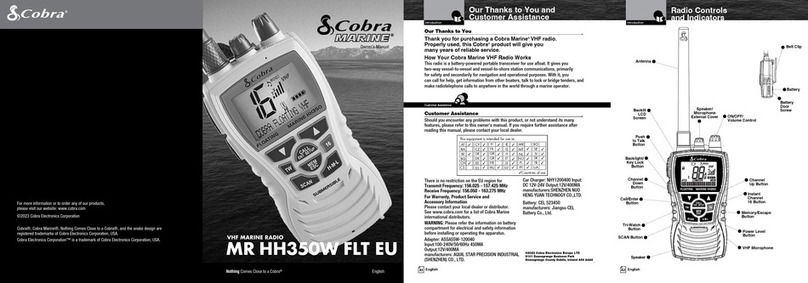
Cobra Marine
Cobra Marine MR HH350W FLT EU owner's manual
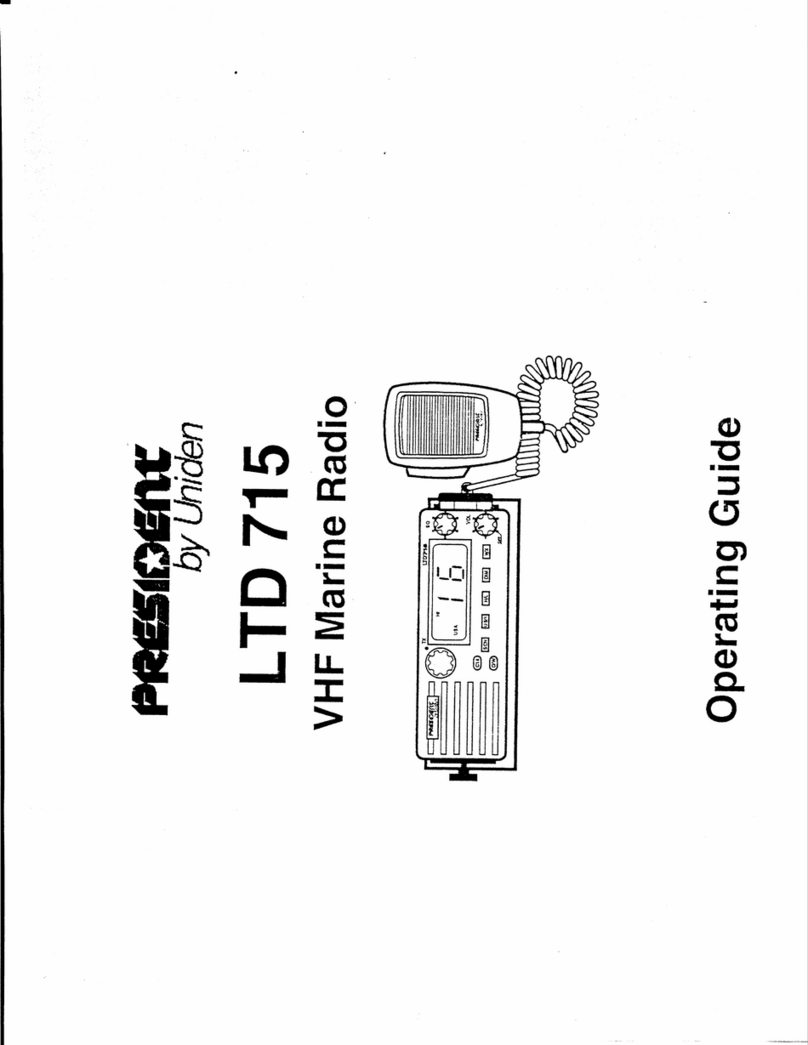
PRESIDENT
PRESIDENT LTD 715 operating guide
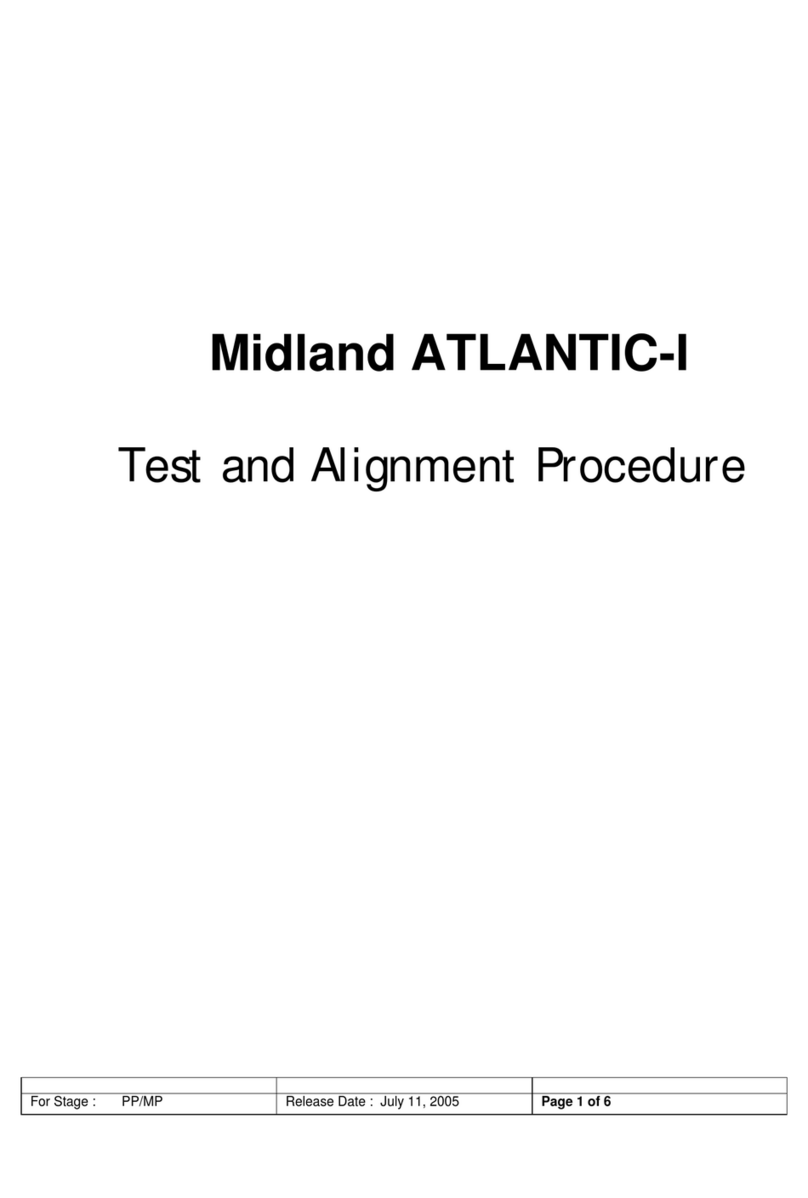
Midland
Midland Atlantic-I Test and Alignment Procedure
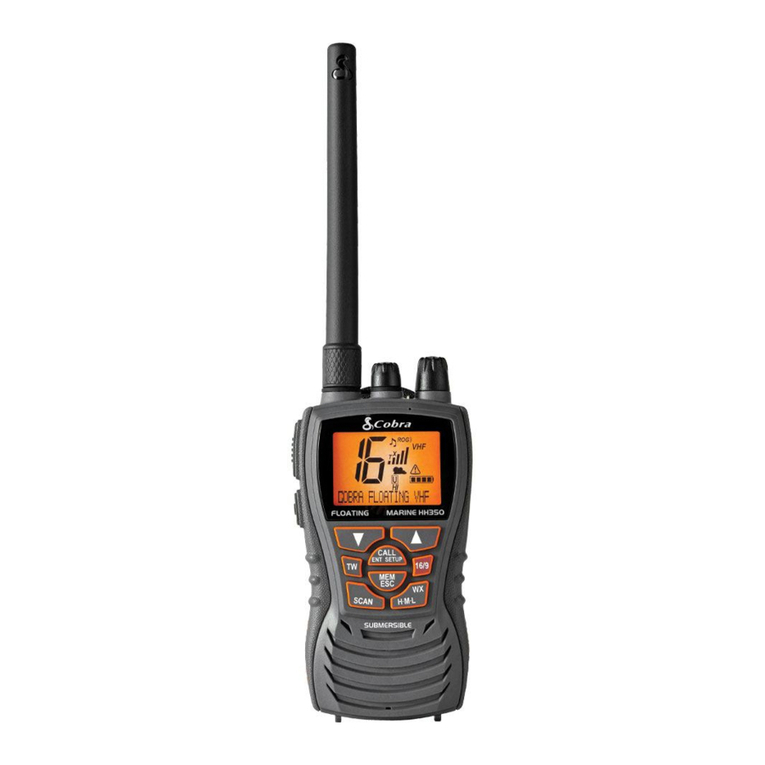
Cobra Marine
Cobra Marine MR HH350 FLT EU owner's manual
uAvionix
uAvionix tailBeaconX STC Instructions for Continued Airworthiness and Maintenance Manual
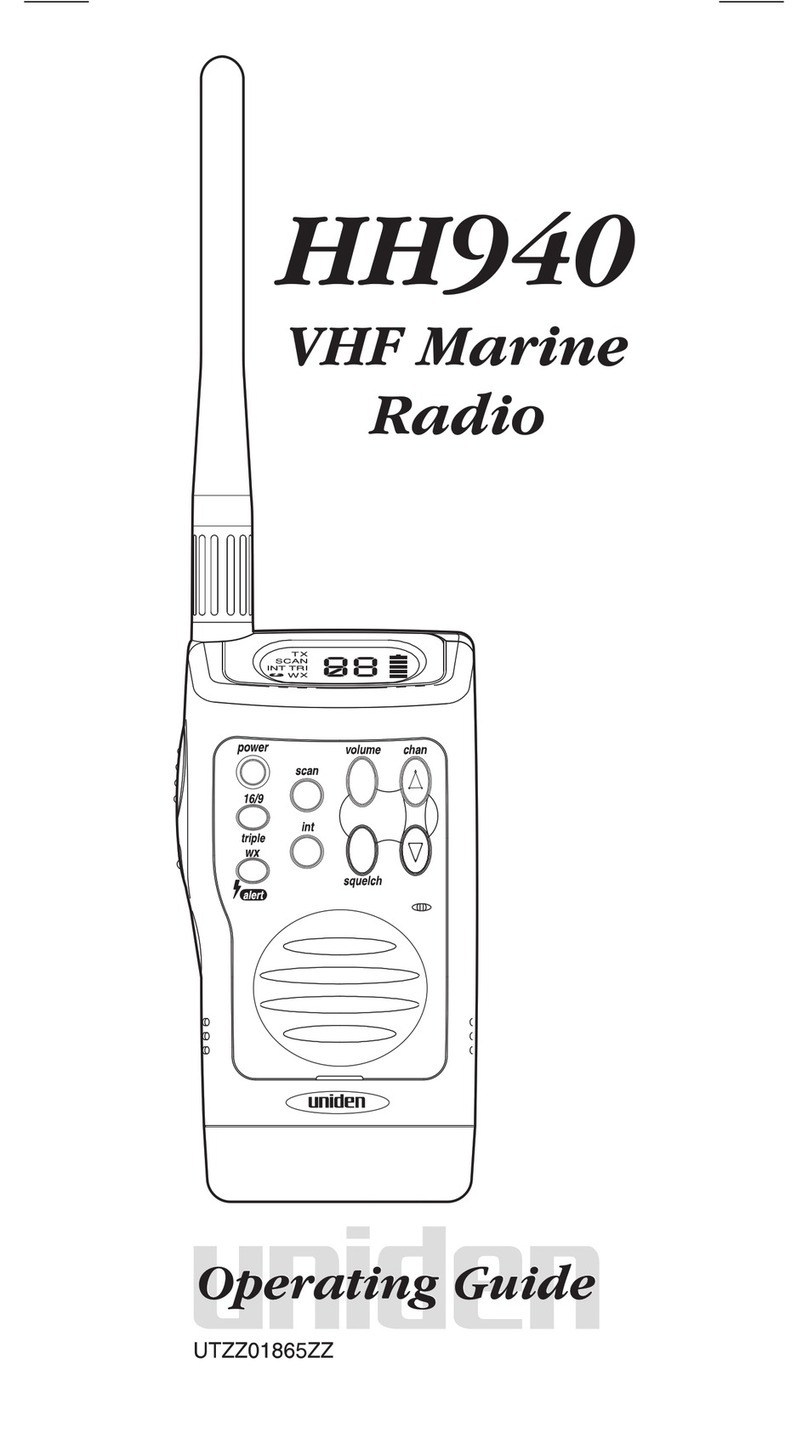
Uniden
Uniden VHF HH940 operating guide
